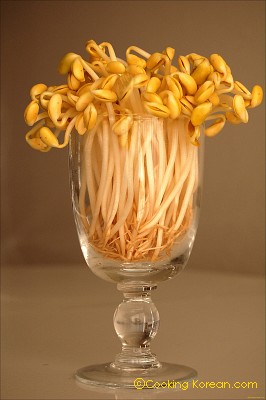
In US, I see a lot of other Asian restaurants serving mungbean sprouts but don’t see any of them serving dish cooked with soybean sprouts. I wonder if Koreans are only people having traditionally eaten soybean sprouts. Please let me know if any of you knows about this.
Although they are not as popular as mungbean or alfalfa sprouts, of all the beansprouts, soybean sprouts contains the most nutritional values. That’s why soybean, in traditional Chinese medicine, is called the king of all beans. The sprouting process produces more selenium, iron, calcium, zinc, and numerous other nutrients than soy bean. The soy bean sprout has the highest protein to calorie ratio of any vegetable.
Compared to mungbean sprouts, they are quite large, about 4-5inch (10 – 12cm) in length and have a pale ivory color. The yellowish colored soybean attached at the end is about the size of a peanut. These sprouts are almost always cooked, even for raw dishes. This is not only because of their relatively denser texture, but also because raw soybean sprout is difficult to digest.
This sprout has fantastic crunchy texture and it is not so much used as a source of flavor, but for the textural interest they can bring to noodle, soup or stir fried dishes. The end of soybean sprouts has a small brown stingy protrusion. Most Korean cooking books say these stingy end must be removed before cooking but I will leave it to you whether to do this or not. This string has a habit of getting between the teeth and doesn’t look very good, but it is a very labor intensive procedure to pinch them off. So, I personally do or don’t depending on preparation time available and who I serve to.
In Korean market, you will find soybean sprouts in bag, packs, and boxes of different brands and producers. Choose the ones that are bright in color and short and chubby in shape. Old soybean sprouts have brown marks on surface and look exhausted so try to avoid them.
|


